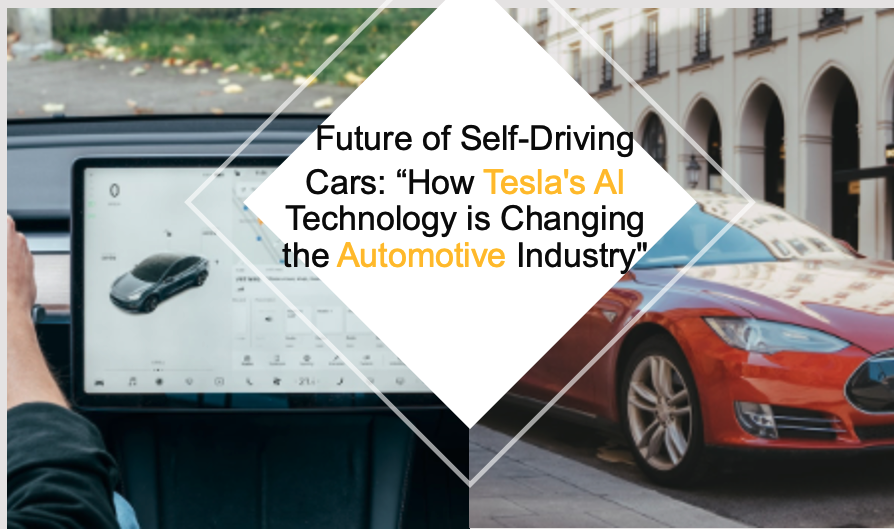Future of Self-Driving Cars: “How Tesla's AI Technology is Changing the Automotive Industry".
Self-driving cars are rapidly approaching reality, and Tesla is at the vanguard of this technological revolution. Tesla has been able to develop advanced self-driving features that are changing the way we think about cars by utilising artificial intelligence (AI) technology.
We'll look at how Tesla's AI technology is changing the automotive industry in this article. We will also discuss some real-world examples of how these technologies are used.
1. Autopilot
Autopilot is one of Tesla's most well-known self-driving features. Autopilot is an advanced driver assistance system that allows Tesla vehicles to automatically steer, accelerate, and brake. This technology can detect lane markings, other vehicles, and even pedestrians, making it an extremely sophisticated safety feature.
Tesla's Autopilot system works by analysing the environment around the car and making driving decisions in real-time using a combination of sensors, cameras, and AI algorithms. This technology has the potential to reduce accidents and improve overall driving safety.
Use case example.
Since 2018 when a Tesla Model S equipped with Autopilot was involved in a fatal crash. Tesla has improved the technology and has highlighted the need for continued advancements in self-driving technology, as well as the importance of proper driver training and education.
2. Complete Self-Driving
Full Self-Driving is another self-driving feature that Tesla is developing (FSD). FSD is intended to allow Tesla vehicles to navigate roads without human intervention, making them fully autonomous vehicles. Tesla cars will be able to drive themselves in a variety of environments, including highways, city streets, and even parking lots, thanks to FSD.
Tesla's FSD system works by analysing real-time data from the car's sensors and cameras to make driving decisions using AI technology. This technology has the potential to transform our perceptions of transportation and mobility.
Use case example.
While Tesla has been testing FSD from the beta mode to more ready-to-deploy advanced systems, it is important to note that the technology has not yet received wide public approval. While using FSD, Tesla has emphasised that drivers should remain alert and ready to take over at any time.
3. Energy Conservation
Tesla is using AI to improve the energy efficiency of its vehicles in addition to self-driving technology. Tesla's AI algorithms analyse driving behaviour, traffic patterns, and even weather conditions to optimise energy consumption and increase vehicle range.
This technology has the potential to reduce carbon emissions and increase electric vehicle adoption. Tesla has made electric vehicles more practical and accessible for everyday use by using AI to improve energy efficiency.
Use case example.
Tesla launched a new feature dubbed "Power Day" in 2021, in which it stated ambitions to develop a new battery technology that will increase the energy efficiency of its vehicles. Tesla has made electric vehicles more feasible and competitive in the automotive sector by employing AI to optimise energy efficiency and increase battery life.
4. Remote Control
Remote access is another way Tesla is using AI technology to change the automotive industry. Users can use Tesla's mobile app to remotely control certain features of their vehicle, such as locking and unlocking doors, adjusting climate control, and even summoning the car to their location.
This technology works by communicating with the car's sensors and cameras using AI algorithms, allowing the user to control the car from a distance. This feature can improve user convenience and accessibility, and it could even be used for self-driving ride-sharing services in the future.
Use case example.
Tesla launched a new feature called "Smart Summon," in 2020, which allows users to summon their car to them in a parking lot. While this feature shows the potential for remote access technology in the future.
5. Enhanced safety feature
Tesla is using AI to improve its safety features in addition to its self-driving capabilities. Tesla's AI algorithms can analyse data from the car's sensors and cameras to detect and alert the driver to potential hazards. This technology prevents accidents by automatically applying brakes or steering away from obstacles.
These enhanced safety features reduce accidents and save lives. The enhanced Tesla features improve vehicle safety by using AI to analyse the environment around the car and make real-time decisions.
6. Creative Design
Tesla is using AI technology to create innovative vehicle designs that are altering our perceptions of automobiles. Tesla's AI algorithms can analyse sensor and camera data to create new vehicle designs that are more aerodynamic, efficient, and sustainable. These inventive designs have the potential to alter our perceptions of transportation and mobility. Tesla has made electric vehicles more practical and accessible for everyday use by using AI to optimise vehicle design.
Use case example.
Tesla unveiled a new design for its CyberTruck in 2020, which features an angular design, unlike any other vehicle on the market. While the design has received mixed reactions, it demonstrates Tesla's commitment to using AI technology to create innovative and environmentally friendly vehicle designs.
Conclusion
Tesla's use of artificial intelligence technologies is transforming the automotive sector in a variety of ways. Tesla is one of the key players in automotive innovation, from advanced self-driving capabilities like Autopilot and Full Self-Driving to energy-efficient car design.
These real-world use cases show how artificial intelligence may be utilised to improve safety, efficiency, and sustainability in the automotive sector. With continuing investment in AI research and development, we can anticipate Tesla and other firms to develop even more innovative and advanced technology in the coming years.
